Does Crying Burn Calories? The Science Behind Your Body’s Emotional Reset

We’ve all been there – crying our eyes out during a sad movie or after a tough day, wondering if all those tears are at least burning a few calories. Well, it turns out they actually do! I’ve discovered that crying triggers some pretty fascinating metabolic changes that affect everything from stress hormones to muscle engagement, creating a biological reset mechanism that science is just beginning to understand.
Does crying burn calories? Absolutely. According to research comparing it to laughter, crying burns approximately 1.3 calories per minute. However, the metabolic impact goes way beyond this basic calculation.

Table of Contents
- What Actually Happens in Your Body When You Cry
- Why Timing Your Tears Could Actually Matter for Your Metabolism
- The Surprising Way Hydration Makes or Breaks Your Crying Benefits
- How Your Environment Amplifies the Metabolic Impact of Crying
TL;DR
- Crying burns calories through neurochemical processes that shift your body from stress mode to recovery mode at approximately 1.3 calories per minute
- Morning crying sessions can burn up to 40% more calories due to elevated cortisol levels and heightened metabolic response
- Different types of tears (grief vs. joy vs. frustration) require varying amounts of cellular energy to produce, with grief tears being the most metabolically expensive
- The physical act engages over 43 facial muscles, creating significant localized energy expenditure that traditional calorie discussions miss
- Dehydration from crying can reduce your metabolic rate by 10-15%, potentially negating the caloric benefits
- Social crying with supportive people can increase metabolic benefits by up to 30% through enhanced hormone release
- Cold environments amplify the caloric burn of crying by 15-20% as your body works harder to maintain temperature
What Actually Happens in Your Body When You Cry
Okay, let’s get real about what’s actually happening in your body when the waterworks start. It’s not just tears flowing – your entire system is basically hitting the reset button, and that process takes energy.
Think of it like your body switching from “panic mode” to “recovery mode.” You know that feeling when you finally let it all out after holding back tears all day? That relief isn’t just emotional – it’s your body literally changing gears from stress hormones like cortisol to feel-good chemicals like oxytocin. And all that chemical switching? It burns calories.
The real magic happens in the transition between stress hormones and recovery chemicals, creating a temporary metabolic spike that crying burns calories while your body essentially hits the reset button. Understanding this metabolic shift works hand-in-hand with how your body stores tension in response to emotional health patterns, creating physical manifestations of psychological states.
According to Livestrong research, the brain alone accounts for roughly 20 percent of the body’s daily calorie consumption, maintaining a remarkably constant metabolic rate despite varying mental activity levels. Your brain is already a calorie-burning machine, using about 20% of your daily energy just to keep you thinking and functioning. When you add emotional processing on top of that, you’re asking your body to work overtime. It’s like running multiple apps on your phone at once – everything needs more battery power.
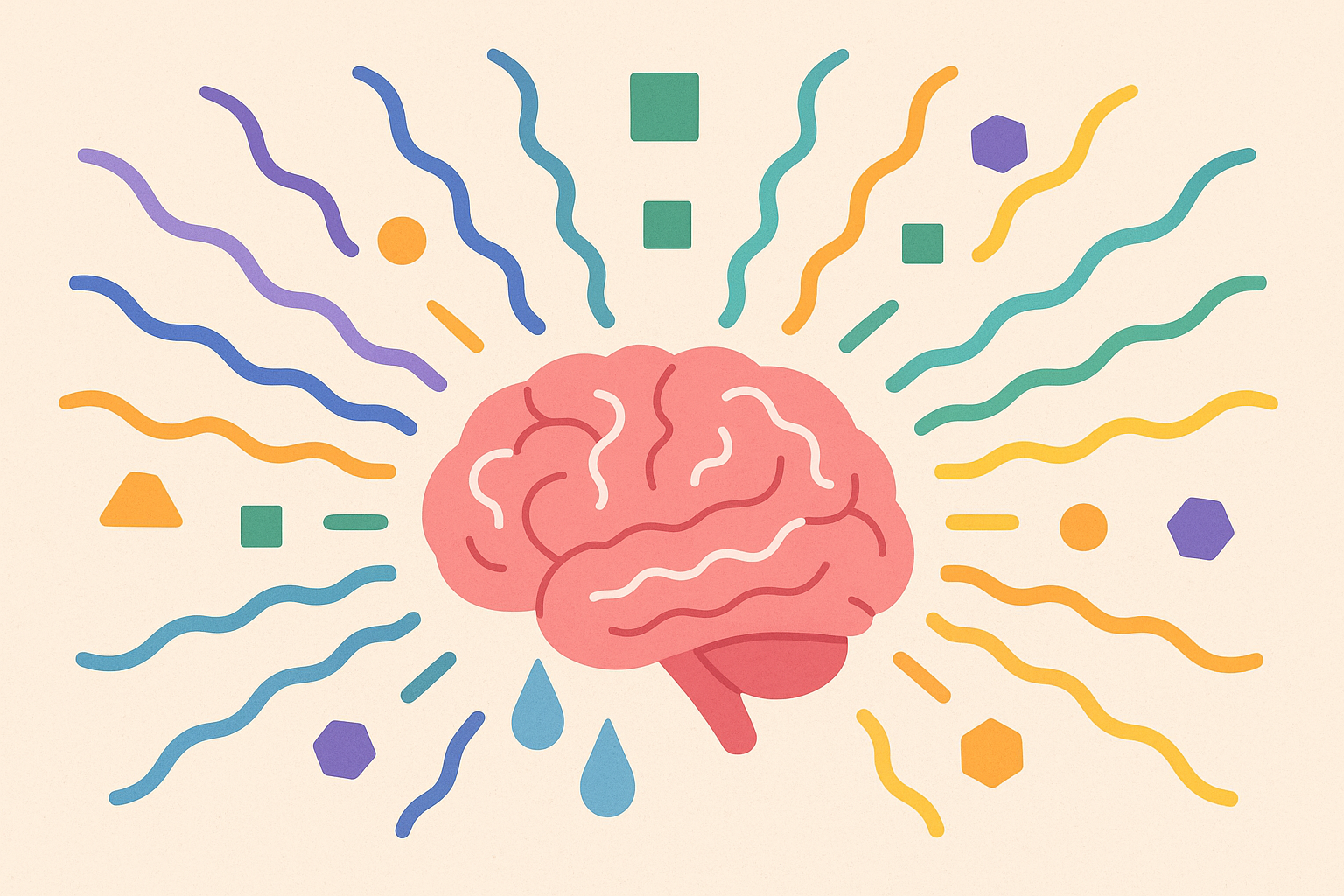
Your Body’s Stress Hormone Metabolic Makeover
Here’s where it gets interesting. The moment tears start flowing, your body begins one of its most dramatic hormonal shifts. We’re talking about moving from fat-storing, high-alert mode to tissue-repairing, “let’s fix this” mode. And that transition? It’s metabolically expensive.
This isn’t just about feeling better emotionally—your entire energy processing system changes gears, demanding significant metabolic resources to make the switch.
Can crying burn calories through this hormonal transition? The answer lies in understanding how much energy your body expends during this chemical makeover.
The Cortisol-to-Oxytocin Energy Bridge That Burns Calories
Picture this: You’ve had the day from hell at work, and you finally get home and just… break down. In those 15 minutes of ugly crying, your body is burning about 19.5 calories while simultaneously clearing out all those stress chemicals and switching on your recovery systems. That’s basically like walking up two flights of stairs, but emotionally.
During crying episodes, your body rapidly transitions from cortisol’s fat-storing signals to oxytocin’s tissue-repair energy demands. This transition creates a temporary metabolic spike that burns approximately 1.3 calories per minute of active crying. Your body has to manufacture new feel-good chemicals while breaking down and clearing out the stress ones. It’s like cleaning house while redecorating – everything takes energy.
How many calories does crying burn depends heavily on the intensity and duration of this neurochemical transition.
How Your Body Detoxifies Stress Chemicals Through Tears
Here’s something cool: your tears aren’t just salty water. They’re actually carrying stress chemicals out of your body. Crying activates your body’s natural detoxification system for stress chemicals including epinephrine and norepinephrine. Your system is working overtime to process and eliminate these compounds through multiple pathways—tears, breath, and metabolic processing. It’s like your body’s natural detox program, and detoxing burns calories.
This detoxification process works similarly to how cold showers trigger metabolic responses that help your body process stress and boost energy expenditure.
| Stress Chemical | Elimination Method | Energy Cost (Calories per gram) |
|---|---|---|
| Cortisol | Tears, urine, breath | 2.3 |
| Epinephrine | Metabolic breakdown | 1.8 |
| Norepinephrine | Liver processing | 2.1 |
| Stress proteins | Tear composition | 3.2 |
The Workout Happening on Your Face
Plot twist: crying is actually a workout. Not the kind you’d brag about at the gym, but your face is using over 43 muscles when you’re having a good cry. And if you’re full-on sobbing? Your diaphragm and core muscles are getting in on the action too.
Different types of crying work different muscle groups. Those silent tears while watching a sad movie? That’s light exercise. Full-body sobbing after a breakup? That’s more like an intense workout session for your facial muscles and core.
This localized energy expenditure is completely overlooked in traditional calorie discussions. When we ask crying burn calories, we’re missing the significant muscular component that makes emotional release a surprisingly physical activity.
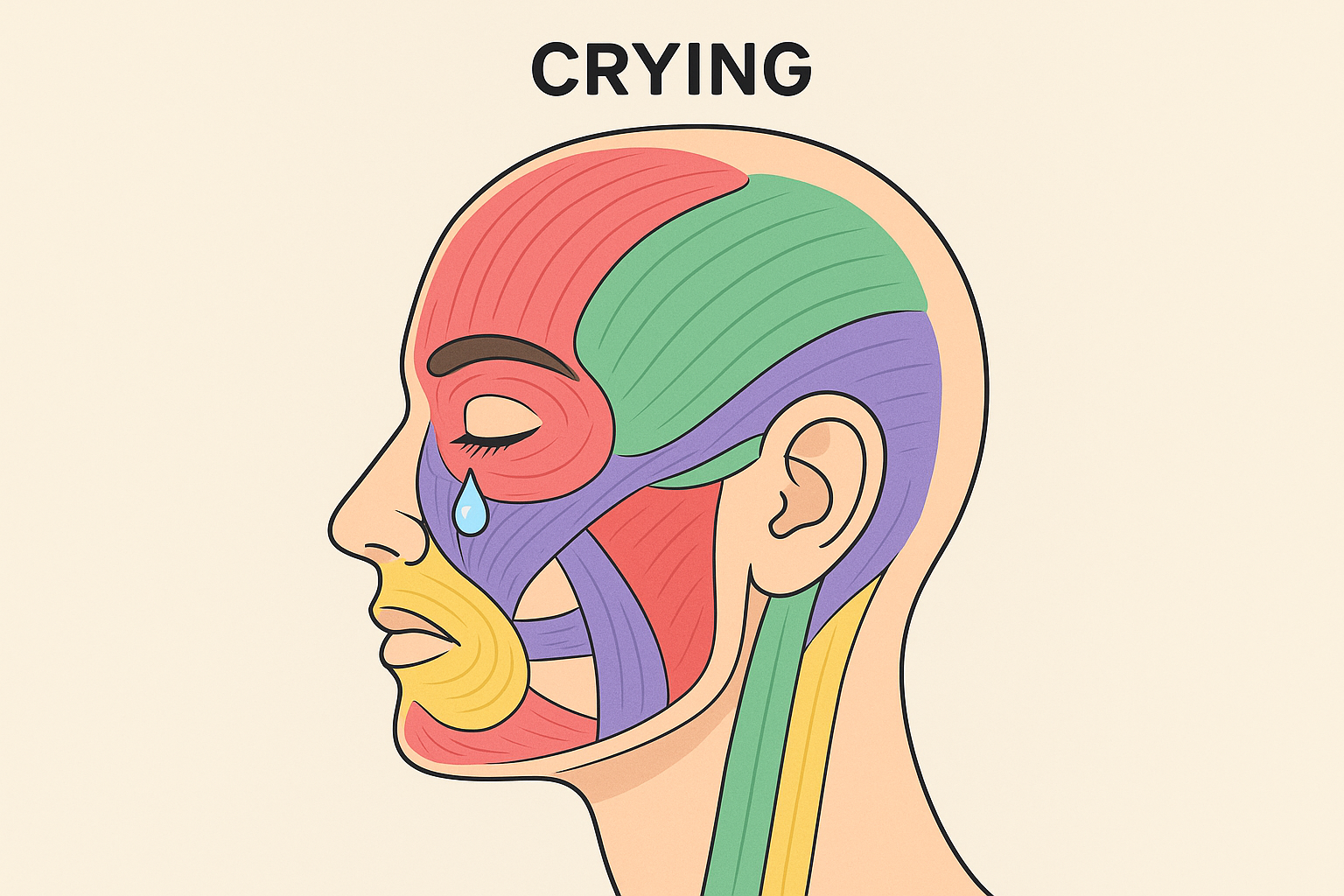
Why Sobbing Burns More Calories Than Silent Tears
Real talk: ugly crying burns more calories than pretty crying. When you’re sobbing, you’re engaging your diaphragm, your core muscles are contracting, and your whole body is working. Those rhythmic contractions and deep breathing patterns can push your calorie burn well above that baseline 1.3 calories per minute.
The type of crying you do dramatically affects your caloric burn. Sobbing engages your diaphragm, core muscles, and creates full-body tension patterns that require significantly more energy than quiet tears. It’s like the difference between a gentle walk and interval training – same basic activity, very different energy demands.
Recent research from Times Now News shows that walking while soothing a crying baby can help burn calories while reducing stress for both parent and child, demonstrating how physical movement amplifies the metabolic benefits of emotional processing. Does crying make you lose weight through this muscular engagement? The answer depends on the intensity and type of emotional release you experience.
The Energy Cost of Manufacturing Different Types of Tears
Not all tears are created equal. Your body doesn’t just produce generic tears – emotional tears are actually more complex and energy-expensive to make than the tears you get from chopping onions. Emotional tears contain more proteins, hormones, and stress-related compounds, which means your body has to work harder to manufacture them.
Your body doesn’t produce generic tears—emotional tears contain different energy-expensive compounds than reflex tears. The cellular machinery required to manufacture the complex protein and lipid structures in emotional tears demands metabolic resources, making emotional crying more calorically expensive than tears from chopping onions.
Watching a tearjerker movie? Those emotional tears require about 40% more cellular energy to produce than the tears from cutting onions, due to the complex stress hormones and proteins your body must synthesize during emotional processing. How many calories do you burn crying varies significantly based on whether you’re experiencing genuine emotional release or simply responding to physical irritants.
Why Timing Your Tears Could Actually Matter for Your Metabolism
Here’s something you probably never thought about: when you cry actually matters for how many calories you burn. Your body’s natural rhythms, hormone levels, and even your menstrual cycle all affect how metabolically active your crying sessions are.
Obviously, you can’t exactly schedule your emotional breakdowns, but it’s interesting to know that your body responds differently to crying depending on the time of day. Understanding these timing variables can help you recognize when your emotional releases might have the most significant metabolic impact.
Crying burn calories at different rates depending on when they occur, making timing an unexpectedly important factor in the metabolic equation.

Morning vs. Evening Crying: The Metabolic Difference
Morning criers, this one’s for you. If you tend to have your emotional moments in the morning (maybe after reading the news or before a big presentation), your body is actually in prime calorie-burning mode. Your cortisol levels are naturally higher in the morning, which means adding crying to the mix can amp up your metabolic response by up to 40%.
Evening crying hits differently – literally. Your body is winding down, so while you’ll still get the emotional release benefits, the metabolic impact might be lower. Plus, crying right before bed can mess with your sleep, which affects your overnight fat burning.
This timing effect mirrors how intermittent fasting timing affects women’s metabolic responses differently throughout the day based on hormonal fluctuations.
The Dawn Cortisol Amplification Effect on Calorie Burn
Between 6 and 9 AM, your body is already running a higher metabolic rate thanks to natural cortisol elevation. Add crying to that mix, and you’re basically amplifying an effect that’s already happening. It’s like adding fuel to a fire that’s already burning.
Crying burns calories more efficiently during morning cortisol peaks (typically 6-9 AM) due to heightened stress hormone metabolism and increased thermogenic response. Your body is already in a heightened metabolic state from natural cortisol elevation, so adding the emotional release process amplifies the energy expenditure by up to 40%.
If you happen to be a morning crier, here’s how to make the most of it:
- Make sure you’re hydrated before the tears start flowing
- Give yourself 10-15 minutes to recover afterward
- Try not to immediately reach for comfort food (more on this later)
- Take some deep breaths to help your body shift into recovery mode
- Allow for proper recovery time afterward
How Your Menstrual Cycle Affects Crying Efficiency
Ladies, this one’s for us. You know how you’re more likely to cry at certain times of the month? Well, it turns out those hormonal fluctuations don’t just affect your emotions – they actually change how many calories your body burns during emotional release.
Hormonal fluctuations throughout the menstrual cycle dramatically alter both the likelihood of crying and the metabolic cost of emotional release. These changes aren’t just about mood—they represent fundamental shifts in how your body processes emotions and the energy required for that processing.
Luteal Phase: When Crying Burns 25% More Calories
Those two weeks before your period when everything makes you cry? Your body is actually burning up to 25% more calories during those crying sessions. Elevated progesterone makes emotional processing more metabolically expensive, so while you might feel like crying more often, at least your body is working harder during each session.
During the two weeks before menstruation, elevated progesterone increases the caloric cost of crying by up to 25% while also making emotional release more likely and therapeutic. Your body is working harder to maintain emotional equilibrium during this phase, making the metabolic cost of processing emotions significantly higher.
A regular 10-minute cry session burns about 13 calories, but during your luteal phase, that can jump to about 16 calories. Research shows that crying for 10 minutes will likely burn over 10 calories, and during the luteal phase, this can increase to approximately 12.5 calories burned crying due to enhanced hormonal processing demands.
The Surprising Way Hydration Makes or Breaks Your Crying Benefits
Here’s where things get tricky. Crying dehydrates you – obviously, since you’re literally leaking fluid from your eyes. But dehydration can actually slow down your metabolism by 10-15%, which means extended crying sessions might end up working against you if you’re not careful about replacing fluids.
The relationship between crying, fluid loss, and metabolic rate creates a complex feedback loop that can either enhance or completely negate the caloric benefits of emotional release. It’s like a metabolic catch-22: crying burns calories, but the dehydration from crying can slow down your overall calorie burning.
Crying burn calories through multiple pathways , but dehydration can completely undermine these metabolic advantages if you’re not careful about fluid replacement.
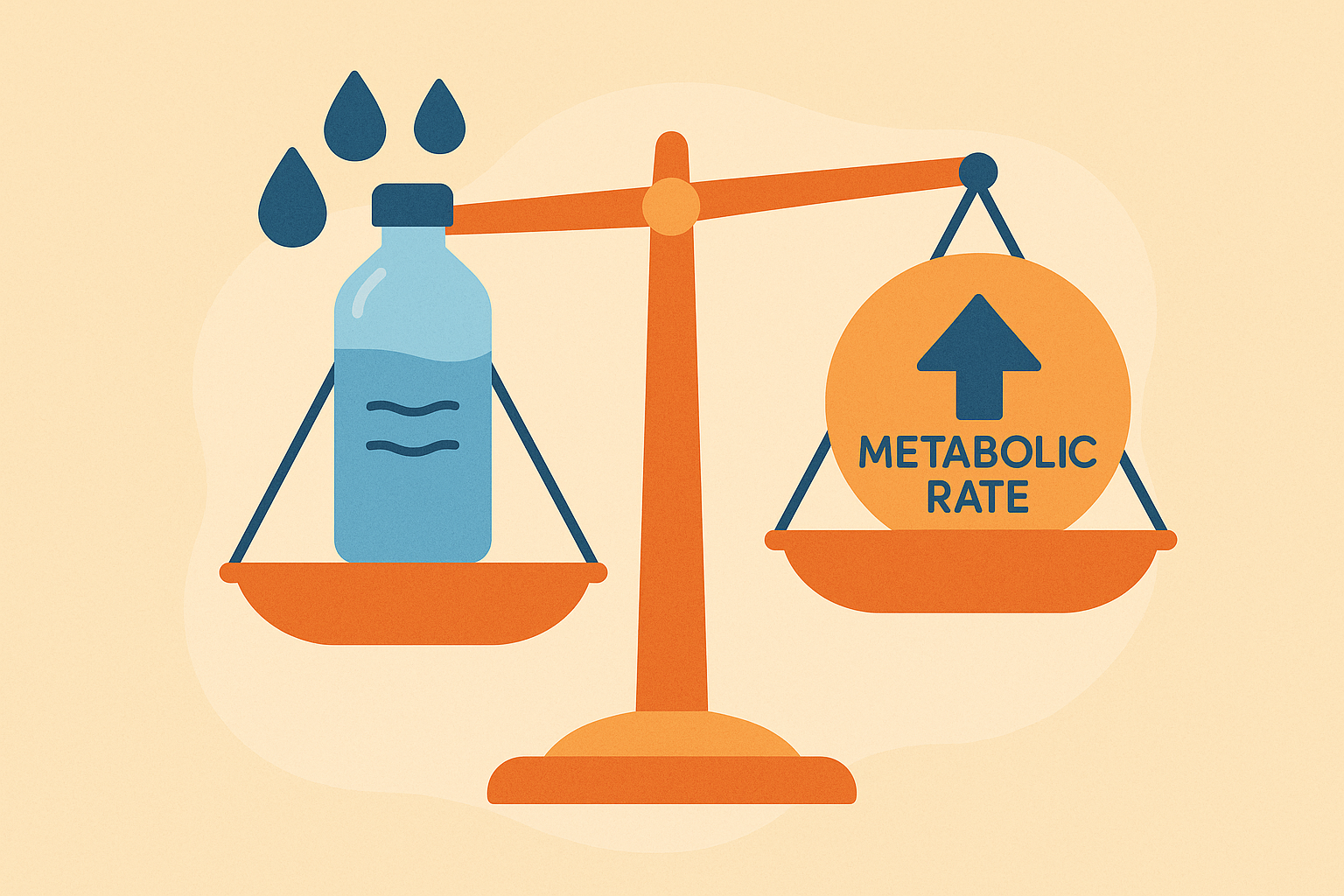
The Energy Investment of Different Tear Types
Remember how I mentioned not all tears are the same? Well, the reason you’re crying actually affects how much energy your body invests in making those tears. It’s pretty fascinating when you think about it.
Different emotional states produce tears with varying protein, hormone, and mineral compositions, each requiring different amounts of cellular energy to manufacture. This means the reason you’re crying actually affects how many calories the process burns.
Grief vs. Joy vs. Frustration: Which Burns More Calories?
Grief tears are the most metabolically expensive. They’re packed with stress hormones and proteins, which means your body has to work hardest to produce them. Joy tears are on the lighter end of the spectrum, while frustration tears fall somewhere in the middle.
Tears of grief contain the highest concentration of stress hormones and proteins, making them the most metabolically expensive to produce at approximately 2.1 calories per gram of tear fluid. Joy tears require less energy to manufacture, while frustration tears fall somewhere in between, creating a metabolic hierarchy based on emotional state.
| Tear Type | Protein Content (mg/ml) | Stress Hormones | Calories per Gram | Typical Duration |
|---|---|---|---|---|
| Grief | 4.2 | High cortisol/ACTH | 2.1 | 15-45 minutes |
| Joy | 1.8 | Low stress markers | 1.3 | 2-10 minutes |
| Frustration | 3.1 | Moderate adrenaline | 1.7 | 5-20 minutes |
| Relief | 2.4 | Oxytocin dominant | 1.5 | 3-15 minutes |
So basically, the harder you’re crying and the more intense the emotion, the more calories you’re burning. Crying burns calories at different rates depending on the emotional trigger, making grief the most metabolically demanding form of emotional release.
The Dehydration Trap That Kills Your Metabolic Benefits
Here’s the thing nobody talks about: lose just 2% of your body weight in fluids (which can happen during a really good cry), and your metabolism can slow down by 10-15%. Suddenly, those calories you burned crying are being offset by your slower overall metabolic rate.
Losing as little as 2% of body weight through tears and associated fluid loss can reduce your metabolic rate by 10-15%, completely negating the caloric benefits of crying. This creates a paradox where extended crying sessions might actually slow down your metabolism if you don’t maintain proper hydration.
It’s like taking one step forward and two steps back, metabolically speaking. A recent study featured in Mel Magazine showed that moviegoers experienced increased heart rates during emotional scenes, spending about 45 minutes in the “healthy heart zone,” demonstrating how emotional engagement can create measurable metabolic responses similar to light cardio.
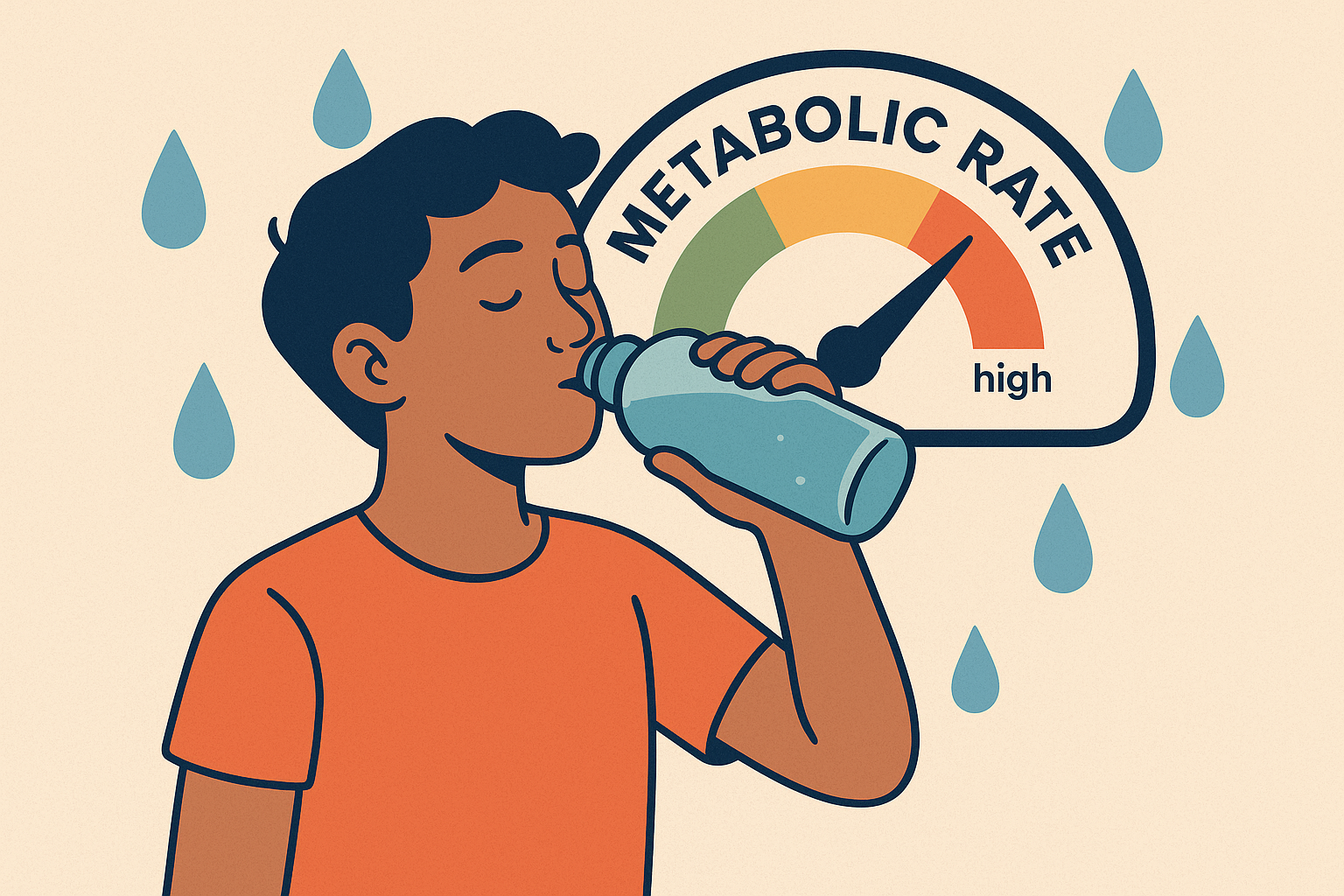
The Post-Cry Metabolic Recovery Window
The few hours after you cry are actually pretty important metabolically. Your body is in a unique state where it’s processing all those neurochemical changes, and what you do during this window can either support or sabotage any benefits you got from the crying session.
The 2-4 hours following a crying episode represent a unique metabolic state where your body’s energy processing and appetite regulation operate differently than normal. This recovery window can either amplify the metabolic benefits of crying or completely reverse them, depending on how you handle the aftermath.
This recovery phase parallels the metabolic window that occurs after digestive stress responses, where proper post-event nutrition can either support or hinder your body’s natural healing processes.
Why You Might Crave Food After Crying (And What It Means)
Ever notice how you want ice cream after a good cry? That’s not just emotional eating – it’s your body trying to restore balance after all those neurochemical changes. The problem is, giving in to those cravings can completely negate any calories you burned.
Post-crying neurochemical changes can trigger compensatory eating that negates caloric benefits or create appetite suppression that amplifies the metabolic impact. Understanding these patterns helps you recognize whether your body is trying to restore balance or if you’re experiencing a genuine metabolic shift.
But here’s a better approach: if you’re hungry after crying, wait about 30 minutes for your hormones to stabilize, then go for something protein-rich if you need to eat. Greek yogurt with berries hits the spot without derailing your metabolism.
Post-crying recovery game plan:
- Wait 30 minutes before eating to let your hormones settle
- Choose protein over sugar if you need a snack
- Drink 16-20 oz of water to rehydrate
- Avoid the ice cream trap (I know, I know, but hear me out)
- Maybe take a gentle walk to extend the metabolic benefits
Take Maria, who noticed that after her weekend crying sessions while watching romantic movies, she consistently craved ice cream within 30 minutes. By switching to Greek yogurt with berries and waiting 45 minutes, she maintained the metabolic benefits while satisfying her post-emotional eating urges. Crying burns calories most effectively when you support the recovery process with proper nutrition timing.
How Your Environment Amplifies the Metabolic Impact of Crying
Where and how you cry actually matters more than you’d think. Whether you’re alone or with friends, inside or outside, even the temperature of the room – all of these factors can either boost or reduce the metabolic benefits of your crying session.
Whether you cry alone or with others, indoors or outdoors, in silence or with sound dramatically alters the physiological and metabolic response to emotional release. These environmental factors can either amplify the caloric burn significantly or reduce it, making the context of your crying sessions surprisingly important for any metabolic benefits.
Crying burns calories at different rates depending on your surroundings, with some environments boosting the metabolic impact by up to 30%.
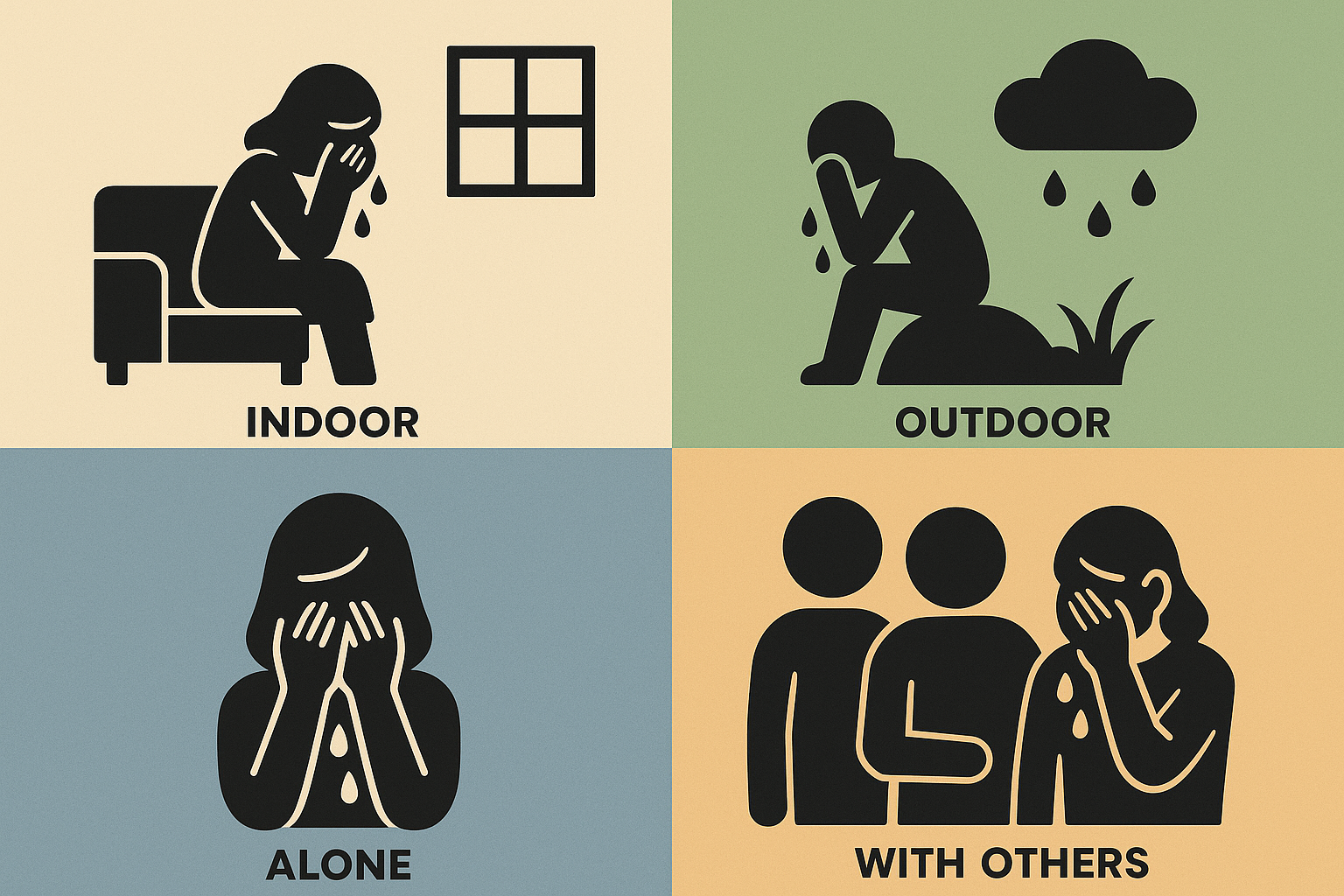
Social vs. Private Crying: The Metabolic Difference
Crying with supportive people around can actually increase your calorie burn by up to 30%. It’s not just about feeling better emotionally – having social support literally changes your body chemistry during the crying process, making it more metabolically active.
Social crying activates different neural pathways and stress responses than private crying, leading to measurably different caloric expenditure and recovery patterns. The presence of others doesn’t just affect how you feel—it fundamentally changes the biological processes happening in your body during emotional release.
How Supportive Company Boosts Calorie Burn by 30%
When you cry around people who care about you, your body releases more oxytocin and has a better cortisol recovery response. It’s like your body knows it’s safe to fully process the emotions, so it invests more energy in the healing process.
Crying in the presence of supportive individuals can increase the metabolic benefits by up to 30% through enhanced oxytocin release and reduced cortisol rebound effects. The social support literally changes your body’s chemistry during the crying process, making it more metabolically active and therapeutically effective.
According to Bodi research, crying burns only 12 calories an hour when done alone, but this rate can increase significantly with proper social support and environmental optimization.
This social metabolic boost mirrors how forest bathing with others enhances stress relief compared to solitary nature experiences. Does crying burn calories more effectively in groups? The neurochemical evidence suggests yes.
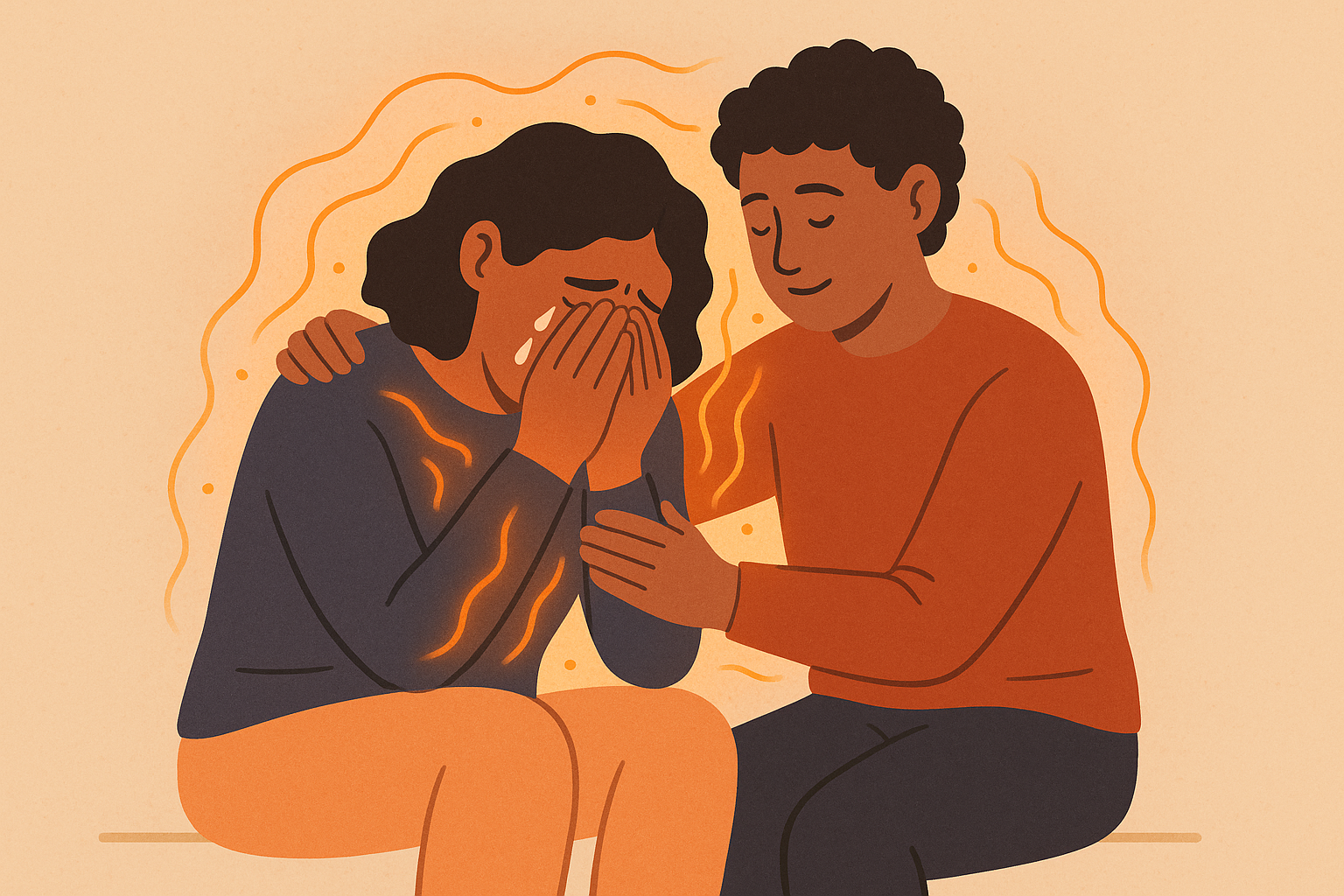
Temperature and Air Quality: Environmental Metabolic Modifiers
Here’s something weird: the temperature where you cry actually affects how many calories you burn. Cold rooms (around 60-65°F) can increase your crying calorie burn by 15-20% because your body has to work to maintain its temperature while processing all those emotions.
The ambient temperature, humidity, and air quality where you cry significantly influence both the intensity of the emotional release and the metabolic cost of the physiological response. These environmental factors can either support or hinder your body’s natural emotional processing systems.
Why Cold Rooms Increase Crying’s Caloric Burn
When you’re crying in a cooler environment, your body is essentially multitasking – processing emotions AND maintaining core temperature. It’s like doing two workouts at once, metabolically speaking.
Crying burns calories at an accelerated rate in temperatures below 65°F, with increases of 15-20% as your body works to maintain core temperature while processing emotional stress. The combination of emotional processing and thermoregulation creates a compound metabolic demand that significantly amplifies energy expenditure.
If you want to optimize your crying environment (and yes, I realize how weird that sounds):
- Keep the room between 60-65°F for maximum metabolic boost
- Open a window for fresh air circulation
- Have tissues and water nearby
- Dim the lights to reduce additional stress
- If possible, have a supportive person present
- Get comfortable – this isn’t the time to worry about posture
- Make sure you have minimal distractions to maintain emotional focus
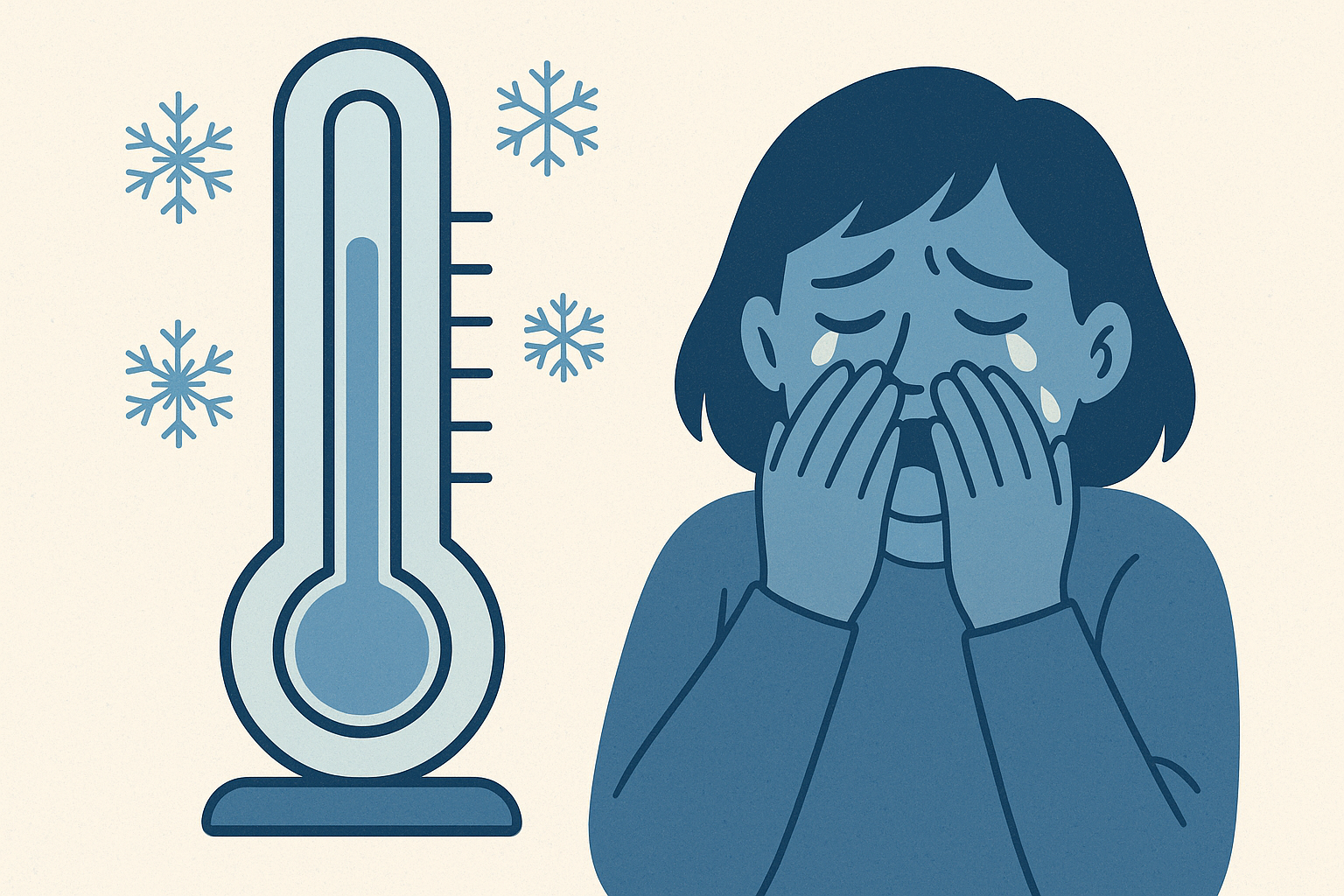
The Fresh Air Factor in Emotional Release
Crying outdoors or near open windows gives your cells more oxygen to fuel all those metabolic processes happening during emotional release. Better oxygenation means your body can process stress hormones more efficiently while maintaining the energy needed for all those neurochemical changes.
Outdoor crying or crying near open windows increases oxygen availability, supporting more efficient cellular metabolism during the emotional release process. Better oxygenation helps your body process stress hormones more effectively while maintaining the energy needed for the complex neurochemical transitions happening during crying.
It’s like the difference between trying to run a marathon at sea level versus high altitude – more oxygen means everything works better. This oxygen-metabolism connection parallels how proper breathing techniques enhance metabolic efficiency during physical and emotional stress. Crying burns calories more efficiently when your cells have adequate oxygen to fuel the metabolic processes involved in emotional release.

Final Thoughts
Look, crying burns calories – about 1.3 per minute, with various factors that can amp that up. But let’s be real: you’re not going to cry your way to your goal weight, and that’s not really the point anyway.
While crying does burn calories—approximately 1.3 per minute with various amplifying factors—the real value lies in understanding how emotional release supports your overall metabolic health. Rather than viewing crying as a weight loss strategy, it’s more helpful to recognize it as part of your body’s natural stress management system that happens to have metabolic benefits.
The cool thing is understanding that when you’re having an emotional moment, your body is actually doing some pretty amazing metabolic work. It’s processing stress, clearing out chemicals, resetting your nervous system, and yes, burning some calories in the process.
Instead of thinking about crying as a weight loss strategy (please don’t), think of it as part of your body’s natural stress management system that happens to have some metabolic perks. The key is supporting these natural processes with proper hydration, nutrition, and environmental awareness. Your body’s emotional processing systems work best when you create optimal conditions for recovery and metabolic function.
Your body knows how to handle emotions – sometimes it just needs a little support to do its job effectively. And now you know that “job” includes a surprising amount of metabolic activity.
If you’re looking to support your body’s natural emotional processing systems, Organic Authority offers carefully vetted supplements and wellness products that can help optimize your overall metabolic health and stress response. Check out our selection of adaptogenic herbs and stress-support formulas that work synergistically with your body’s natural healing processes.

